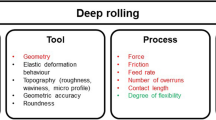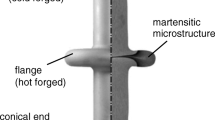Abstract
Railway axles, which are an important component of railway vehicles, are generally manufactured using high-speed forging processes. To investigate the microstructure evolution and flow behavior during forging processes, a series of isothermal hot compression and heating tests were conducted in the temperature range of 900–1200 °C and strain rate range of 0.01–20 s−1. A strain-compensated Arrhenius constitutive relationship was identified for 25CrMo4 steel, and microstructure evolution kinetics, comprising dynamic recrystallization, metadynamic recrystallization, static recrystallization, and grain growth, were determined. A coupled thermomechanical–metallurgical numerical model was established for the high-speed forging of 25CrMo4 steel axles by using the TRANSVALOR Forge software package. The grain size evolution during the multipass high-speed forging process was predicted, and a full-scale axle was fabricated through high-speed forging to verify the predicted results. The predicted and experimentally observed grain sizes had good agreement. Finally, a series of geometric constraints are proposed for the design of round anvils. The reliability and applicability of the proposed constraints were validated by considering the surface quality and microstructure requirements as well as the forming force during chamfering. The results indicated that the proposed constraints can suitably guide the design of anvils for high-speed forging processes.


























Similar content being viewed by others
Data Availability
Not applicable.
References
Chen WJ, Chen H, Li CC, Li CC, Wang XL, Cai Q (2017) Microstructure and fatigue crack growth of EA4T steel in laser cladding remanufacturing. Eng Fail Anal 79:120–129
Huang K, Logé RE (2016) A review of dynamic recrystallization phenomena in metallic materials. Mater Des 111:548–574
Doherty RD, Hughes DA, Humphreys FJ, Jonas JJ, Juul JD, Kassner ME, King WE, McNelley TR, McQueen HJ, Rollett AD (1997) Current issues in recrystallization: a review. Mater Sci Eng A 238(2):219–274
Liu YG, Liu J, Li MQ (2017) Metadynamic recrystallization of 300M steel after isothermal compression. Mater High Temp 34(4):279–288
Sellars CM, Whiteman JA (1979) Recrystallization and grain growth in hot rolling. Met Sci 13(3-4):187–194
Wang SL, Yang B, Zhang MX, Wu HC, Peng JT, Gao Y (2016) Numerical simulation and experimental verification of microstructure evolution in large forged pipe used for AP1000 nuclear power plants. Ann Nucl Energy 87:176–185
Xu G, Wang LN, Li SQ, Wang L (2012) Hot deformation behavior of EA4T steel. Acta Metall Sin Lett 25:374–382
Huo YM, Wang BY, Lin JG (2012) Development of constitutive model of EA4T high-speed train shaft steel based on internal-state-variable method. Appl Mech Mater 189:31–35
Hibbe P, Hirt G (2020) Analysis of the bond strength of voids closed by open-die forging. Int J Mater Form 13(1):117–126
Jang YS, Ko DC, Kim BM (2000) Application of the finite element method to predict microstructure evolution in the hot forging of steel. J Mater Process Technol 101(1–3):85–94
Sherstnev P, Flitta I, Sommitsch C, Hacksteiner M (2008) The effect of the initial rolling temperature on the microstructure evolution during and after hot rolling of AA6082. Int J Mater Form 1:185–188
Huo Y, Bai Q, Wang B, Lin J, Zhou J (2015) A new application of unified constitutive equations for cross wedge rolling of a high-speed railway axle steel. J Mater Process Technol 223:274–283
Buteler DI, Neves PCU, Ramos LV, Santos CER, Souza RM, Sinatora A (2006) Effect of anvil geometry on the stretching of cylinders. J Mater Process Technol 179(1–3):50–55
Dyja H, Banaszek G, Mróz S, Berski S (2004) Modelling of shape anvils in free hot forging of long products. J Mater Process Technol 157–158:131–137
Du SW, Li YT, Song JJ (2015) Optimization of forging process parameters and anvil design for railway axle during high-speed forging. In: ASME 2015 international mechanical engineering congress and exposition. Pp IMECE2015–50695
Xu Y, Birnbaum P, Pilz S, Zhuang X, Zhao Z, Kräusel V (2019) Investigation of constitutive relationship and dynamic recrystallization behavior of 22MnB5 during hot deformation. Results Phys 14:102426
Sellars CM, Davies CHJ (1979). Hot working and forming process, The Metal Society, pp 3–15
Sellars CM, McTegart WJ (1966) On the mechanism of hot deformation. Acta Metall 14(9):1136–1138
Jonas JJ, Sellars CM, Tegart WJMG (1969) Strength and structure under hot-working conditions. Metall Rev 14:1–24
Zener C, Hollomon JH (1944) Effect of strain rate upon plastic flow of steel. J Appl Phys 15(1):22–32
Avrami M (1939) Kinetics of phase change. I: General theory J Chem Phys 7:1103–1112
Avrami M (1940) Kinetics of phase change. II Transformation-time relations for random distribution of nuclei J Chem Phys 8:212–224
Kong LX, Hodgson PD, Collinson DC (2000) Extrapolative prediction of the hot strength of austenitic steels with a combined constitutive and ANN model. J Mater Process Technol 102(1–3):84–89
Poliak EI, Jonas JJ (1996) A one-parameter approach to determining the critical conditions for the initiation of dynamic recrystallization. Acta Mater 44(1):127–136
Quan GZ, Li YL, Zhang L, Wang X (2017) Evolution of grain refinement degree induced by dynamic recrystallization for Nimonic 80A during hot compression process and its FEM analysis. Vacuum 139:51–63
Chen L, Sun W, Lin J, Zhao G, Wang G (2018) Modelling of constitutive relationship, dynamic recrystallization and grain size of 40Cr steel during hot deformation process. Results Phys 12:784–792
Sellars CM, Beynon J (1985). Microstructural development during hot rolling of titanium microalloyed steels, proceedings of international conference on high strength low alloy steels, pp. 142–150
Hodgson PD, Gibbs RK (1992) A mathematical model to predict the mechanical properties of hot rolled C-Mn and microalloyed steels. ISIJ Int 32(12):1329–1338
Sun WP, Hawbolt EB (1997) Comparison between static and metadynamic recrystallization - an application to the hot rolling of steels. ISIJ Int 37(10):1000–1009
Lin YC, Chen MS (2009) Study of microstructural evolution during static recrystallization in a low alloy steel. J Mater Sci 44(3):835–842
Yanagida A, Yanagimoto J (2008) Formularization of softening fractions and related kinetics for static recrystallization using inverse analysis of double compression test. Mater Sci Eng A 487(1-2):510–517
Dong DQ, Chen F, Cui ZS (2017) Investigation on metadynamic recrystallization behavior in SA508-Ш steel during hot deformation. J Manuf Process 29:18–28
Maccagno TM, Jonas JJ, Hodgson PD (1996) Spreadsheet modelling of grain size evolution during rod rolling. ISIJ Int 36(6):720–728
Wang MT, Li XT, Du FS, Zheng YZ (2005) A coupled thermal-mechanical and microstructural simulation of the cross wedge rolling process and experimental verification. Mater Sci Eng A 391(1–2):305–312
Ivaniski TM, Epp J, Zoch HW, Da Silva RA (2019) Austenitic grain size prediction in hot forging of a 20mncr5 steel by numerical simulation using the JMAK model for industrial applications. Mater Res 22:5
Zhang N, Wang BY, Lin JG (2012) Effect of cross wedge rolling on the microstructure of GH4169 alloy. Int J Miner Metall Mater 19(9):836–842
Kingdom U (2009). Metal forming data of ferrous alloys - deformation behaviour. New Ser VIII 2C1:1–5
Du SW, Sun RH, Li YT (2015) Effect of anvil structure on forming quality of railway axles. Suxing Gongcheng Xuebao/Journal Plast Eng 22:26–31
Wang S, Zhang M, Wu H, Yang B (2016) Study on the dynamic recrystallization model and mechanism of nuclear grade 316LN austenitic stainless steel. Mater Charact 118:92–101
Zahiri SH, Davies CHJ, Hodgson PD (2005) A mechanical approach to quantify dynamic recrystallization in polycrystalline metals. Scr Mater 52:299–304
Wen DX, Lin YC, Zhou Y (2017) A new dynamic recrystallization kinetics model for a Nb containing Ni-Fe-Cr-base superalloy considering influences of initial δ phase. Vacuum 141:316–327
Sellars CM (1986). Annealing processes - recovery, recrystallization and grain growth. The 7. Risø international symposium on metallurgy and materials science, Risø, Denmark 8–12 September 1986
Acknowledgments
The authors gratefully acknowledge the financial support of The National Key Research and Development Program of China (Grant No.: 2017YFB0703000).
Author information
Authors and Affiliations
Corresponding author
Ethics declarations
Conflict of interest
The authors declare that they have no conflict of interest.
Code availability
Not applicable.
Additional information
Publisher’s note
Springer Nature remains neutral with regard to jurisdictional claims in published maps and institutional affiliations.
Appendix
Appendix
According to Eq. (1), the following equation can be obtained
From Eq. (31), the following equation can be obtained:
Moreover, sinh(ασ) can be expressed as follows:
From Eq. (33) and the inverse function of Eq. (33), the following equation is obtained:
By combining Eqs. (32), (34) and (2), the following equation is obtained:
Rights and permissions
About this article
Cite this article
Xu, Y., Zhang, Y., Zhuang, X. et al. Numerical modeling and anvil design of high-speed forging process for railway axles. Int J Mater Form 14, 813–832 (2021). https://doi.org/10.1007/s12289-020-01590-9
Received:
Accepted:
Published:
Issue Date:
DOI: https://doi.org/10.1007/s12289-020-01590-9




